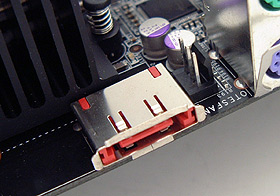 eSATAII (aka
external Serial ATA) is one of the most exciting features to pop on
motherboards recently. When it comes to external mass storage, bandwidth has always been
an issue, and Serial ATA makes even IEEE 1394b's 800Mbps bandwidth
look paltry by comparison. The ABIT AW9D-MAX motherboard has one external SATA (eSATA).
eSATAII (aka
external Serial ATA) is one of the most exciting features to pop on
motherboards recently. When it comes to external mass storage, bandwidth has always been
an issue, and Serial ATA makes even IEEE 1394b's 800Mbps bandwidth
look paltry by comparison. The ABIT AW9D-MAX motherboard has one external SATA (eSATA).
This
connection uses a slightly modified SATA cable (not included), which is better
suited to external connections. Standard internal Serial ATA cables are
sufficient for internal connections, but SATA-IO governing body decided a while
back that the external version should be a somewhat different format, thus
creating the eSATA standard.
eSATA
enclosures for
SATA hard drives are widely available, and the great thing is that hard
drives connected over this standard are just as fast as internal devices. The
connectors are hot swappable, so it makes adding and removing an massive
external hard drive about as complex as plugging in a USB memory key. For anyone
who as ever had to move Gig's of data over a USB cable, eSATA is simply awesome.
The Port 80 Diagnostics card
The two digit Port 80 display is located right on the
PCB, in the lower right hand corner of the ABIT AW9D-MAX motherboard next to the front panel
I/O header. It's the perfect tool for the tweaker in times of hardware trouble,
the little Port 80 device makes life a lot easier.
The standard that dictates what codes
are displayed on the Port 80 card have been around for years, and the values are
the same no matter what brand or model of motherboard you use (if it has the
card anyhow). Even if your motherboard doesn't have one, it's possible to get a
Port 80 diagnostics PCI card to install into the system if you do a lot of
troubleshooting.
